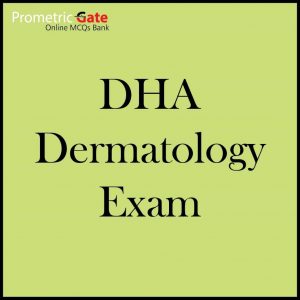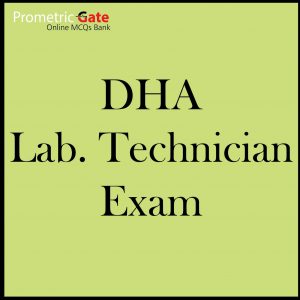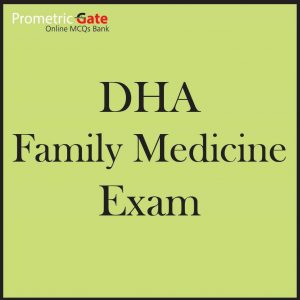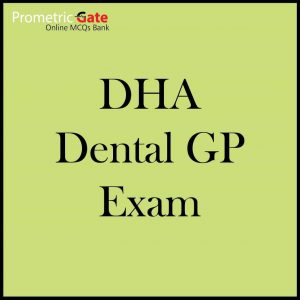DHA Pediatric specialist Exam Materials 2024
Online course materials for 3 months , 6000 new MCQs
Updated 2024
NOTES !!!
– Do not miss ! weekly updated questions,
– All questions are corrected by specialist doctor
– All questions are repeated ! with 80-89 % repeated questions.
– No need to study other sources !
– Enough to pass easily.
Questions samples :
Question 1
A 4-year-old presents with petechiae after a diarrheal illness and is found to have thrombocytopenia and hypertension. His stool studies are positive for E. coli 0157: H7. Which of these lab results would be expected?
A. Elevated creatinine
B. High haptoglobin
C. Low LDH
D. Normal RBCs
E. Positive direct Coombs test
Answer: A
This child has hemolytic uremic syndrome (HUS) secondary to enterotoxic E. coli . Children will present with abdominal pain and fever. HUS is characterized by the triad of microangiopathic hemolytic anemia, thrombocytopenia, and acute renal failure. Given this patient’s hypertension, it is likely he has laboratory evidence of acute renal injury as seen with an elevated creatinine. HUS leads to intravascular hemolysis; therefore, the red blood count is expected to be low and RBC fragments (schistocytes) are often seen on a blood smear. The hemolysis often leads to low haptoglobin as it is bound with hemoglobin from hemolyzed cells and an elevated LDH due to the cell lysis. The direct Coombs test, however, would be negative as patients with HUS do not have an antibodymediated hemolysis.
Question 2
A 11-year-old boy is brought to the doctor with left knee pain. The pain worsens with activity and improves with rest. He denies any history of trauma. Which of the following is the most likely diagnosis?
A. Duchenne muscular dystrophy
B. Osgood-Schlatter disease
C. Osteoporosis
D. Stress fracture
Answer: B
Osgood-Schlatter disease (OSD)
- Inflammation of the insertion of the patellar tendon in the tibial tubercle (tibial tubercle apophysitis).
- It is more common in adolescent boys active in sports.
- OSD is characterized by pain and swelling at the tibial tubercle, the point of insertion of the patellar tendon.
- OSD generally occurs in children 9 to 14 years of age who have undergone a rapid growth spurt. It I bilateral in 25 to 50 percent of cases, although the involvement is typically asymmetric.
- OSD occurs most frequently in participants of sports that involve running, cutting, and jumping (eg, soccer, football, basketball, volleyball, gymnastics, figure skating, ballet).
- OSD disease is an overuse injury caused by repetitive strain and chronic avulsion of the secondary ossiffication center (apophysis) of the tibial tubercle.
- The most common presenting complaint is anterior knee pain that increases gradually over time, from a low-grade ache to pain that causes a limp and/or impairs activity8. Pain is exacerbated by direct trauma, kneeling, running, jumping, squatting, climbing stairs, or walking uphill, and is relieved by rest.
Question 3
Which of the following options presents the ECG feature of a patient with an Ostium secundum atrial septal defect?
A. Sinus bradycardia
B. left axis deviation
C. prolonged PR interval
D. right axis deviation
Answer: D
An ECG demonstrates sinus rhythm, often with evidence of right atrial enlargement manifested by tall, peaked P waves (usually best seen in leads II and V2) and prolongation of the PR interval. The QRS axis is slightly directed to the right (+100º), and the precordial leads reveal right ventricular enlargement of the so-called volume overload type that is characterized by an rSR’ pattern in leads V3 R and V1 with normal T waves. The QRS duration may be mildly prolonged because of right ventricular dilation. This mimics the finding in right ventricular conduction delay. A significant proportion (20-40%) of children with secundum atrial septal defect may not have abnormal ECG findings.
Uncommonly, a patient with a secundum atrial septal defect may demonstrate a superior QRS axis with right ventricular enlargement, mimicking findings observed in the ECG of a patient with an ostium primum atrial septal defect.
Question 4
Pediatric patient has symptoms of epiglottitis with stridor and distress. What’s your next step?
A. Admit to ICU and refer to ENT(No intubation in choices)
B. Adrenaline nebulization
C. IV Antibiotic
D. IV hydrocortisone
Answer: A
Epiglottitis is associated with fever, difficulty in swallowing, drooling, hoarseness of voice, and typically stridor. Stridor is a sign of upper airways obstruction and is a surgical emergency. The child often appears acutely ill, anxious, and has very quiet shallow breathing with the head held forward, insisting on sitting up in bed. The early symptoms are insidious but rapidly progressive, and swelling of the throat may lead to cyanosis and asphyxiation. Epiglottitis may require urgent tracheal intubation to protect the airway, though this is not always the case. Tracheal intubation can be difficult due to distorted anatomy and profuse secretions. Spontaneous respiration is ideally maintained until tracheal intubation is successful. A surgical airway opening (cricothyrotomy) may be required if intubation is not possible
Question 5
A 12-year-old girl presents with lack of pubertal development, short stature, and broad chest. What are the appropriate next steps in evaluating this patient?
A. Echocardiogram and blood pressure measurement in all four extremities
B. Genetic testing for Alagille syndrome
C. Genetic testing of the genes involved in Noonan syndrome
D. MRI of the heart
E. Reassurance that there are no cardiac issues in this condition
Answer: A
The features presented here most likely represent those of Turner syndrome, or monosomy X. Approximately 25–30% of patients have associated congenital heart disease, predominately left-side obstructive lesions. Coarctation of the aorta is present in 10–20% of patients; therefore, screening for coarctation is indicated at 5-year intervals. Unlike hypoplastic aortic arches, major intracardiac anomalies are not commonly found with isolated coarctation of the aorta; however, there is a high association of this lesion with Turner syndrome and with bicuspid aortic valve. Genetic testing of the genes involved in Noonan syndrome would not be indicated unless Turner is ruled out. There can be overlap of the features between Noonan and Turner. Genetic testing for Alagille syndrome is not indicated. While an MRIof the heart may be a more sensitive way to detect subtle coartcation, it is not indicated as the first-line test.
Question 6
A 10-year-old male presents to the emergency department with a large, erythematous targetoid lesion on his arm after returning from a family trip in Connecticut. You suspect Lyme disease. What is the first-line treatment for Lyme disease?
A. Ceftriaxone
B. Doxycycline
C. No need to treat, self-resolving illness
D. Trimethoprim–sulfamethoxazole
E. Vancomycin
Answer: B
Doxycycline is the drug of choice for treatment of early, localized Lyme disease in children 8 years of age and older. Treatment duration is for 14 days. For children under 8 years of age, amoxicillin is recommended. Precautions with doxycycline include avoidance of exposure to the sun (eg, the use of sunscreen) because a rash develops in sun-exposed areas in about 20% of persons on the drug. Treatment in early stages of Lyme, when only erythema migrans is present but systemic symptoms are lacking, almost always prevents later stages from occurring.
Question 7
A child is observed to walk a distance of 10 feet and climb stairs. Although he cannot yet form full sentences, the child can speak a few words. The age of this child is most likely :
A. 10 months old
B. 15 months old
C. 2 years old
D. 3 months old
E. 3 years old
Answer: B
Age 12 to 18 Months Gross Motor Skills (view handouts) can get to standing position alone creeps up stairs can scoop and recover an object by 15 months, walks well alone walking, pulls a pull-toy seats self on chair Language Development (view handouts) has 10-15 words will point to one body part will point to at least one picture uses jargon, i.e., unintelligible “foreign” language with inflection imitates some words follows simple directions accompanied by gestures answers simple questions nonverbally points to objects, pictures, and family members makes animal sounds such as “moo.”
Question 8
A patient with diagnosis of rhinosinusitis has presented to you again for his symptoms. Which of the following is most sensitive test for maxillary sinus?
A. Biopsy
B. CT
C. MRI
D. X-ray
Answer: B
hinosinusitis is typically divided among four subtypes: acute, recurrent acute, subacute, and chronic, based on patient history and a limited physical examination. In most cases, therapy is administered based on this classification. Antibiotic therapy along with hydration and decongestants is indicated for 7 to 14 days in patients with acute, recurrent acute, or subacute bacterial rhinosinusitis. For patients with chronic disease, the same treatment regimen is indicated for an additional 4 weeks or more, and a nasal steroid may also be prescribed if inhalant allergies are suspected as an etiologic agent. Nasal endoscopy and computed tomography of the sinuses are reserved for circumstances that include a failure to respond to therapy as expected, spread of infection outside the sinuses, a question of diagnosis, and when surgery is being considered. Laboratory tests are rarely needed and are reserved for patients with suspected allergies, cystic fibrosis, immune deficiencies, mucociliary disorders, and similar disease states. X ray is best initial test. CT is most accurate test.





Habeeb Ali –
No materials like yours
Thanks
Mai yasin –
Many thanks
Glad to deal with you
د.نهى حسين –
شكرا لكم لمساعدتي في النجاح .. مش عارفة كيف اشكركم
Abdul Hamid ali –
You are no. 1 site in providing real MCQs
Ali Ali –
Nice source
Hamad ahmed –
🌷